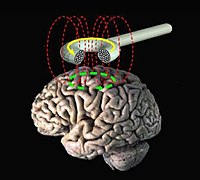
Photo from wikipedia
Objective cerebellum is involved in a wide number of integrative functions; its role in pain processing has been scarcely investigated. We tried to clarify this aspect using transcranial cerebellar direct… Click to show full abstract
Objective cerebellum is involved in a wide number of integrative functions; its role in pain processing has been scarcely investigated. We tried to clarify this aspect using transcranial cerebellar direct current stimulation (tcDCS) and studying changes in perceptive threshold (PT), pain intensity (VAS) and laser evoked potentials (LEPs) responses (N1 and N2/P2). Materials and methods Fifteen subjects were studied before and after anodal, cathodal and sham tcDCS. LEPs were obtained using a Nd:YAP laser; signals were amplified, band pass filtered. The left hand dorsum was stimulated by laser pulses with short duration (5 ms) and small diameter spots (5 mm). VAS was evaluated by delivering laser pulses at two different intensities, respectively two and three times the pain threshold (PT). Results Cathodal polarization dampened the PT and increased the VAS score, while the anodal one had opposite effects ( p p Discussion tcDCS modulates pain perception and its cortical correlates. As it is effective on N1 and N2/P2 components and these responses are generated by parallel and partially segregated spinal pathways reaching different cortical targets, we speculate that the cerebellum modulates the activity of both somatosensory and cingulate cortices, interfering with the sensory-discriminative as well as emotional dimensions of pain. Conclusions Present findings prove Cerebellum involvement in pain processing and prompt further investigations on tcDCS employments as novel therapeutic tool in chronic pain patients.
Journal Title: Clinical Neurophysiology
Year Published: 2017
Link to full text (if available)
Share on Social Media: Sign Up to like & get
recommendations!